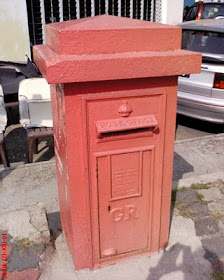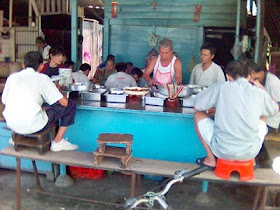Pages
Monday, 29 November 2010
Straits Settlements Post Box ( Regina Victoria) Penang
Straits Settlements Post Box ( King Edward VII ) Penang
British Malaya Post Box Kuala Lumpur
Friday, 26 November 2010
Eat, Talk, Coffee.. etc in Kedai Kopi, Kopi Tiam Malaysia/Singapore – No.3
Eat, Talk, Coffee...etc in Kedai Kopi, Kopi Tiam Malaysia/Singapore – No.1
Others could be a makeshift stall along a busy road, with just plastic sheets "roofs" as a shade, or along the beach and public parks – these are usually “Mamak Stalls” run by Indians ( Muslim Tamils) mainly found in Malaysia.
The coffee made by Indians are usually sweeter and not too thick on the coffee essence. Their tea are usually “tarik(malay) or pulled to cool the heat of the beverage. As such, should you want your coffee/tea hot, just say “Panas” (malay) or hot.
Chinese Coffee shops serves their coffee/tea in porcelain cups with saucers and they are not “tarik”. The Chinese think that having air bubbles in the beverage is not good for internal health.
To cool the beverage, you can pour the coffee/tea onto the saucer and sip your drink from there, with a long and satisfying slurpy noise ( that’s what my Grandfather used to do and that’s where I get my beverage – from the saucer when I was very young)
In order to get a thicker coffee essence, you have to order “Kopi Kau” – Coffee Thicker or “Kopi Poh” – Thinner Coffee. What the Kopi “barista”would do is to add more or lesser hot water to the coffee essence ( concentrated liquid coffee) to get the texture.
When you order “Kopi” ,it is hot coffee, with sugar, and condensed milk .”Kopi-O” is black coffee with sugar.”Kopi Kosong” is just black coffee. Black “English Tea” would be ordered the same way i.e. “Teh” is hot tea, with sugar, and condensed milk.”Teh-O” is black tea with sugar and .”Teh Kosong” is just black tea.
Other beverages available includes the following, with a certain terms only used in Singapore –e.g.
Tuck kew ( Kick ball in Hokkien) – Milo ; a chocolate and malt powder drink which is mixed with hot milk; The brand labels of the product usually has a boy or girl doing sports; and for some reasons, the label of the boy playing football stuck with the coffee shop waiters!
Tiau her ( Catch fish in Hokkien) – Chinese tea ;coffee shops in Singapore serve Chinese tea in tea bags ; as such dunking the bag up and down the hot water to infuse the tea is just like tugging the fishing line!
Friday, 19 November 2010
Old Chartered Bank, Klang Town Selangor


The old Chartered Bank branch ( Annex building) of Klang Town located at the junction of Jalan Istana & Jalan Dato Hamzah
The old Chartered Bank of India, Australia & China began financial business in Singapore in 1859 and Penang 1875. As such, the Dutch styled building could have been built about the late 1800’s as it housed the Chartered Bank branch in Klang Town.
European Style had influenced the architecture of Malaya especially the styles that were modified according to the tropical climate and combined with architecture influence of Malay, Classical Portuguese, Dutch and English. This building certainly has Dutch influences with unique Dutch Gables. The main building could have been used for the banking business, with covered footbridges connected to an annex which could have housed the living quarters of the employees and stables for horses and carriages – as observed from its carriage house type of doorways.
1909 Sultan Suleiman Building, Klang Town, Selangor

The Sultan Suleiman Building of Klang Town - caught my eye whilst we drove through town along Jalan Stesen

Built in 1909 to house the Klang District Office during British Malaya, it was designed in a Western Classical Style by PWD (Public Works Department) architect Arthur B. Hubback. The building also accommodated the Land Office, Town Board and PWD then.
Called by the locals as the "White House" of Klang, it was declared a natural heritage ( one of the first in Selangor) on 15 December 2009
Thursday, 18 November 2010
Klang Town Railway Station, Selangor

The name for Klang Town was probably derived from the word "Kilang" , which meant "warehouse"from an old Malay word. In the old days, Klang Town would have been full of warehouses to store tin for transhipment from the mining fields in the Klang Valley further the east of the town, to the Port, 6 miles miles to the west.
In the 1890's, commodities such as coffee and rubber added to the load for export from Malaya. This led to the construction of the Klang Railway Station to accommodate the growth of traffic not only for goods, but passengers as well. The extension of the railway from Klang Town to the Port of Swettenham, was constructed between 1895 to 1901 - making Selangor Railway System then, one of the busiest in Malaya.
Thursday, 21 October 2010
Parit Sulong Memorial, Johore
 The old buildings on the west side of the bridge where the Japanese herded the wounded allied soldiers. They were machine gunned at the back of the building next to the big tree on the left of the building.
The old buildings on the west side of the bridge where the Japanese herded the wounded allied soldiers. They were machine gunned at the back of the building next to the big tree on the left of the building. Brief of the third VC receipient, Lt Col Charles Anderson, 2/19th AIF Battalion during the Battle of Malaya. The first VC receipient was Squadron Leader Arthur Scarf, RAF (posthumously) and second was Brig Gen Arthur Edward Cumming, 2/12th Frontier Force Regiment
Brief of the third VC receipient, Lt Col Charles Anderson, 2/19th AIF Battalion during the Battle of Malaya. The first VC receipient was Squadron Leader Arthur Scarf, RAF (posthumously) and second was Brig Gen Arthur Edward Cumming, 2/12th Frontier Force RegimentParit Sulong Memorial commemorates the Battle of Muar and the massacre of 150 wounded Australian and Indian soldiers by the Japanese Imperial Army during WW2. The site is located on the east side of the new bridge that was built in 1997 to replace the original one that was built in 1930.
Shop Houses in Kluang
 Row of Shophouses in Kluang with unique lion designs ( The British Imperial Lion or Chinese Mythical Lion?) perched on top of the shop front
Row of Shophouses in Kluang with unique lion designs ( The British Imperial Lion or Chinese Mythical Lion?) perched on top of the shop frontKluang
During WW2, the allies had the Austalian Battalions and the RAF stationed in Kluang -
"At Kluang we were billeted under canvas with the Australians ( 19th & 29th Battalions ) on the perimeter of Kluang Aerodrome . Food was very good with plenty of meat , butter , bread and cheese . The sections job was to repair and keep in operation the overhead lines between Kluang and Mersing . There were only two Blenheim bombers stationed on the airfield"extracted from www.bbc.co.uk/ww2peopleswar/stories
However, during the Japanese invasion, the Japanese was reported to have located their forward base from KL to Kluang on 23 Jan 1942 and used the airbase to flying their planes over Singapore during the fighting withdrawal for the allied forces.
Again, during the Malayan Emergency from 1948 to 1960, Kluang was the centre of operations against the CT in Johore as the town was approximately in the centre of Johore State. A large army garrison comprising HQ 63 Gurkha Inf Brigade and the 1/7 Gurkha Rifles, and the RAF was based in the vicinity of the aerodrome.
Actually, I was going to Kluang to search for the location of the airbase and the garrison. I was distracted somewhat by the beauty of the prewar shophouses in the old part of Kluang Town. Please see the pictures appended above.
Maybe next time, I will spend more time in Kluang to look for the location of the aerodrome. Last, I wonder why shop houses in Kluang are all mostly Dated?Can anyone out there advise me ?












































